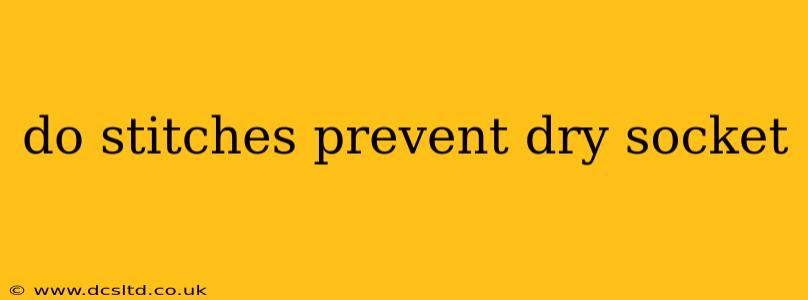Dry socket, medically known as alveolar osteitis, is a painful complication that can occur after a tooth extraction. While many factors contribute to its development, a common question among patients is whether stitches (sutures) play a role in preventing it. The answer isn't a simple yes or no, but understanding the relationship between sutures and dry socket risk can help manage expectations and promote healing.
What is Dry Socket?
Before delving into the role of stitches, let's clarify what dry socket is. It's a painful condition where the blood clot that normally forms in the extraction socket after tooth removal becomes dislodged or fails to form properly. This exposes the underlying bone and nerve endings, leading to significant pain, often described as throbbing and persistent. Bad breath and a foul taste in the mouth are also common symptoms.
Do Stitches Directly Prevent Dry Socket?
Stitches themselves don't directly prevent dry socket. Their primary purpose is to help control bleeding, keep the extraction site clean, and promote proper healing by holding the gum tissue together. While a well-formed blood clot is crucial for preventing dry socket, the stitches aren't the clot's primary support structure. The clot forms naturally through the body's clotting mechanisms.
How Do Stitches Indirectly Help Reduce Dry Socket Risk?
Although stitches don't directly create the blood clot, they contribute to a healing environment that indirectly reduces the risk of dry socket. Here's how:
- Minimized Disruption: Stitches help minimize disruption to the extraction site, reducing the chance of the blood clot being dislodged by food particles, saliva, or other irritants. This is particularly important in the crucial initial healing phase.
- Improved Healing Environment: By holding the gum tissue together, sutures create a more stable and protected environment for clot formation and subsequent healing. This reduces the risk of infection, another factor that can contribute to dry socket.
- Reduced Trauma: Careful surgical technique, including precise placement of stitches, can minimize trauma to the extraction site during the procedure itself, further contributing to a more favorable environment for clot formation.
Other Factors that Contribute to Dry Socket
It's crucial to remember that dry socket isn't solely determined by the presence or absence of stitches. Several other factors play a significant role:
- Smoking: Smoking significantly increases the risk of dry socket. It impairs blood flow and healing.
- Poor Oral Hygiene: Inadequate oral hygiene can introduce bacteria to the extraction site, increasing the risk of infection and dry socket.
- Difficult Extractions: Complex extractions, such as those involving impacted wisdom teeth, are more likely to result in dry socket due to greater trauma to the area.
- Use of Oral Contraceptives: Some studies suggest a potential correlation between oral contraceptive use and a higher risk of dry socket.
- History of Dry Socket: Patients who have experienced dry socket previously are at increased risk of experiencing it again.
How to Minimize Your Risk of Dry Socket
To minimize your risk of dry socket, follow your dentist or oral surgeon's post-operative instructions carefully. This typically includes:
- Avoiding smoking and alcohol.
- Maintaining meticulous oral hygiene (but avoid vigorous rinsing or spitting).
- Following prescribed pain medication and antibiotic regimens.
- Eating a soft diet to avoid disturbing the extraction site.
Does the type of stitch matter in preventing dry socket?
The type of suture used generally doesn't significantly influence the risk of dry socket. The surgical technique and overall post-operative care are far more impactful factors.
Conclusion
While stitches play an indirect role in reducing the risk of dry socket by creating a more stable healing environment, they are not a guarantee against it. Maintaining excellent oral hygiene, following post-operative instructions meticulously, and avoiding smoking are far more critical factors in preventing this painful complication. If you experience concerning symptoms after a tooth extraction, contact your dentist or oral surgeon immediately.
